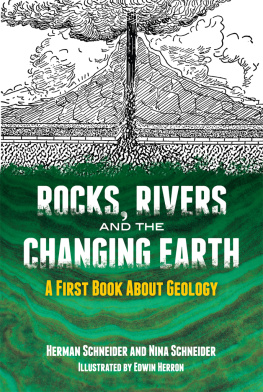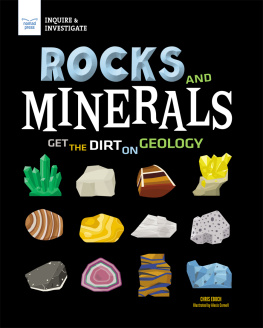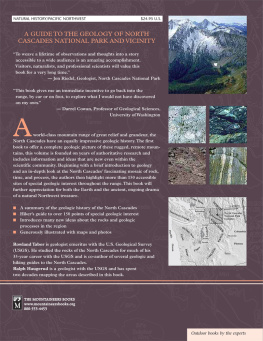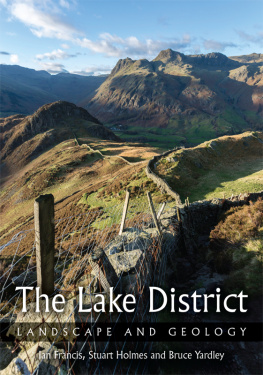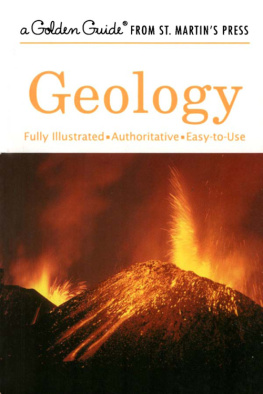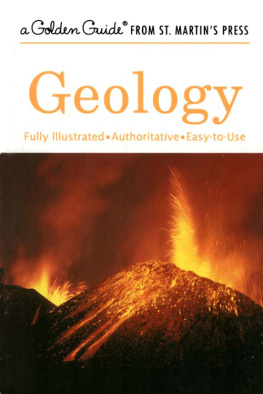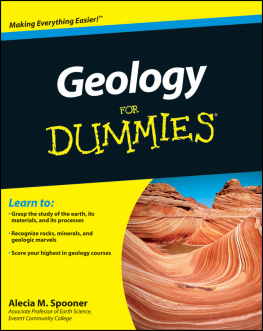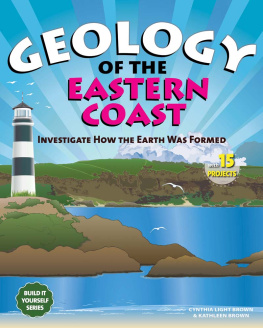ROCKS, RIVERS
AND THE
CHANGING EARTH
A F IRST B OOK A BOUT G EOLOGY
H ERMAN S CHNEIDER AND N INA S CHNEIDER
I LLUSTRATED BY
E DWIN H ERRON
DOVER PUBLICATIONS, INC.
MINEOLA, NEW YORK
Copyright
Copyright 1952 by Herman and Nina Schneider
Copyright Nina Schneider 1988 Trust
All rights reserved.
Bibliographical Note
This Dover edition, first published in 2014, is an unabridged republication of the work originally published by William R. Scott, Inc., New York, in 1952.
Library of Congress Cataloging-in-Publication Data
Schneider, Herman, 1905-2003.
Rocks, rivers, and the changing earth : a first book about geology / Herman Schneider and Nina Schneider ; illustrated by Edwin Herron.Dover edition.
p. cm.
Audience: Grade 4 to 6.
Originally published: New York : W. R. Scott, 1952.
Includes index.
eISBN-13: 978-0-486-79724-3
1. GeophysicsJuvenile literature. I. Schneider, Nina, 19132007. II. Title. III. Title: First book about geology.
QE501.S32 2014
551dc23
2014013582
Manufactured in the United States by Courier Corporation
78201801 2014
www.doverpublications.com

Table of Contents
P ART O NE
T HE L AND T ORN D OWN
P ART T WO
T HE S EA F ILLED I N
P ART T HREE
T HE L AND B UILT U P
P ART F OUR
M AN A ND T HE E ARTH
PART ONE
The Land Torn Down

A Leaf And A Stone
The story of the earth is in a leaf and in a stone; in a cloud and in the sea. The leaf was once a stone; the cloud was once the sea. The earth tells its story over and over againthe leaf will become a stone, the cloud will become the sea again.
The tops of mountains tell us that they were once at the bottom of the sea; and in the sea right now there are coral animals building land that will some day rise far above the sea.
The story of the earth is everywherein the shape of a pebble and the shape of a mountain, in the fresh taste of brook water and the salty taste of the ocean. You are part of the story, and so is the house you live in and the food you eat.
The earth tells a story that you can learn to read. When you know how to read it, you will see the earth in a new way. You will see it as it was long ago, as it is now, and as it will become many years from now.
Rivers To The Sea
Every part of the earth is changing all the time; no part is ever still. Every mountain, every brook, every mud-puddle changes from moment to moment. Some of these changes are so slow that they take millions of years, but others happen quickly. In running brooks and rivers, the changes happen right before your eyes. Lets look at a river and see how it changes.
Every river begins in the clouds. From high above the earth, rain clouds let fall the raindrops that come splattering down on the land. Where the rain falls on a mountainside, you can see a river beginning to flow.
There are all kinds of rivers, big and little, straight and winding, fast and slow. But no matter what kind of river it is, it begins as falling rain.
From Rain To River
To see how rain becomes a river you would have to climb a mountain and watch the raindrops as they strike the soil that covers the mountainside. You cant do that right this minute because you are probably not reading this on a mountainside in the rain. But you can make your own rainstorm on a mountain and see what happens when water falls on soil.

Make your own rainstorm and see what happens when rain falls on a mountainside.
E XPERIMENT . You will need a cup of water to be the rain. A rubber bath sponge will be the spongy mountain soil full of crumpled old leaves. You will also need a dinner plate.
Do this: over the kitchen sink, hold the dish in a slanting position and place the sponge in the dish. Then slowly pour all the water on the higher end of the sponge.
You will find that the water will soak into the sponge until it is filled. When it cant hold any more, you will see the water begin to trickle out of the lower end in a little stream.
Much the same thing happens when rain falls on a mountain. The rain pours down until it hits the soil. The soil soaks up the water like a sponge. When enough rain has fallen, the soil is like a full sponge. Water begins to trickle out in a little mountain stream.
A River Flows Downhill
The water trickles out of the spongy soil, always in a downhill direction. Sometimes its hard to see the downward slant in places where the earth looks flat. But water finds even the smallest down grade and flows in that direction.
E XPERIMENT . You will need a big piece of wax paper and a large plate, cookie tin, or platter.
Do this: put the plate in the sink. Crumple up the wax paper and put it on the plate. Put some small thing under one edge of the plate, so that it will have a slight downhill slant. Pour a little water on the uphill end of the crumpled wax paper and see where it goes.
You will find that the water will work its way down even a very slight slope.

On the paper and on a mountain, water flows downhill.
In the same way the trickle of water on a mountain keeps working its way downward and then joins up with other trickles. Many trickles together form a stream flowing down the mountainside. This stream joins other brooks which have trickled down from other parts of the mountain. Lower down these brooks join and form bigger brooks. And soon the water from all these brooks flowing together is big enough to be called a river.
A River Keeps Flowing
But many rivers keep on flowing all the time, even when it isnt raining. Where does the water in a river come from on days when no rain falls? Heres a way to find out.

E XPERIMENT . You will need the same plate, a bath sponge, and a pitcher of water.
Do this: hold the dish and sponge in a steeply slanting position over the sink. Pour on just enough water barely to fill the sponge, so that little or no water trickles out.
Now quickly pour on a big splash of water and watch what happens.
You will find that the extra water will pour out at the lower end, but it will come out more slowly than you poured it in. It took you only a second to pour a great deal of water on to the sponge, but the stream will keep trickling for several minutes. A sponge can take in quite a bit of water quickly, and then let out a little water slowly for a much longer time.

Rainwater soaks into soil quickly and trickles out slowly.
In the same way, the spongy soil on a mountainside soaks up water. During rainy seasons the water pours in. In the Spring, snow melts and soaks down into the soil, too. The soil drinks up all this water like a great, tremendous sponge. Then, between rains and during drier seasons, the water in the spongy soil keeps trickling out of the soil and down the mountainside. That is why brooks and rivers keep on flowing even when it isnt raining.

